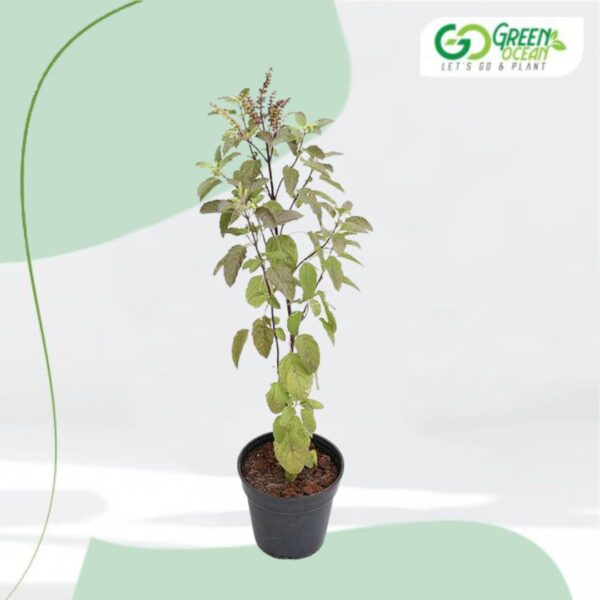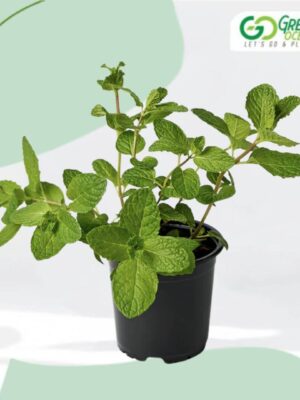Free home delivery over Rs 999

Rama Tulsi
Original price was: ₹200.00.₹99.00Current price is: ₹99.00.
(MRP Inclusive of all taxes)
Dispatch in 3-4 days
Country of origin: India
Description for Rama Tulsi, Tulsi ( Green)
Sow seeds in early spring. Grows best in full sun in moderately rich and well-drained soil kept well watered. Space large-leafed cultivars (such as Thai Magic ) 1 1/2 apart and mulch to retain moisture. Many Hindus have tulsi plants growing in front of or near their home, often in special pots or special small masonry structures. Traditionally, Tulsi is planted in the center of the central courtyard of Hindu houses. The plant is cultivated for religious and medicinal purposes, and for its essential oil. It is widely known across South Asia as a medicinal plant and a herbal tea, commonly used in Ayurveda. Tulsi has been used for thousands of years in Ayurveda for its diverse healing properties. It is mentioned in the Charaka Samhita, an ancient Ayurvedic text. Tulsi is considered to be an adaptogen, balancing different processes in the body, and helpful for adapting to stress. Marked by its strong aroma and astringent taste, it is regarded in Ayurveda as a kind of “”elixir of life”” and believed to promote longevity. It is an elixir for cough; the leaves when chewed after meals acts as a digestive, and when taken before and after cold water bath controls temperature in the stomach and prevents cold. If sprinkled over cooked food in stored water, tulsi leaves prevent bacterial growth.
| COMMON NAME | FLOWER COLOURS | BLOOM TIME | HEIGHT | DIFFICULTY |
|---|---|---|---|---|
| Ajaka,Baranda, Basilic Indien,Brinda,Kala Tulsi, Kemangen, Krishna Tulasi, Tulsa, Manjari,Parnasa, Patrapuspha,Shyama Tulsi, Sri Tulasi, Suvasa Tulasi and Tulsi Patra. | Magenta | Throughout Year.Preferably early summer and late spring. | 1.50 to 2 feet | Easy to grow |
Planting and care
plant care may require a bit of effort, but the results are well worth the work. Not all plants are fragrant, but the most common and hardy do produce a sweet, carrying fragrance. Common is a vine and has larger glossy green leaves than Royal. Both can survive in temperate climates if they are planted in a sheltered area.
| SUNLIGHT | SOIL | WATER | TEMPERATURE | FERTILIZER |
|---|---|---|---|---|
| Full sun | Well-drained soil | Medium | 36-40 degrees C | Apply any organic fertilizer |
Caring for Rama Tulsi
- Basil is a tropical plant but it still dislikes direct sunlight. So, do not keep your basil plant at a spot where the sun is beating down.
- Indirect sunlight is best for basil plants.
- Every leaf has a growth bud, so removing old flower blossoms encourages the plant to make more flowers instead of using the energy to make seeds.
- Clean away from around the base of the rosebushes any trimmed debris that can harbor disease and insects.
Typical uses of Rama Tulsi
Special features: As a seasoning herb in many vegetable and meat dishes, or as a key ingredient of pesto and other condiments.
Culinary use:
- It is considered that consuming five leaves of tulsi on daily basis protects one from different types of diseases along with enhancement in memory power and intelligence.
- Consuming tulsi leave`s juice with water on empty stomach in the morning increases memory power and glow along with an enhanced digestive power.
- Tulsi tea is beneficial in several ways.
Ornamental use: The plant is used for ornamental purpose.
Medicinal use:
- Tulsi may cure fever, cold,cough and sore throat
- Tulsi may beat stress
- Tulsi may desolve kidney stone
- Tulsi may protect the heart as it has medicinal properties
- Tulsi may beat cancer
- Tulsi may help in quitting smoking
- Tulsi may beat stress
- Tulsi may reduce blood sugar level
- Tulsi may keep skin and hair healthy






Reviews
There are no reviews yet.